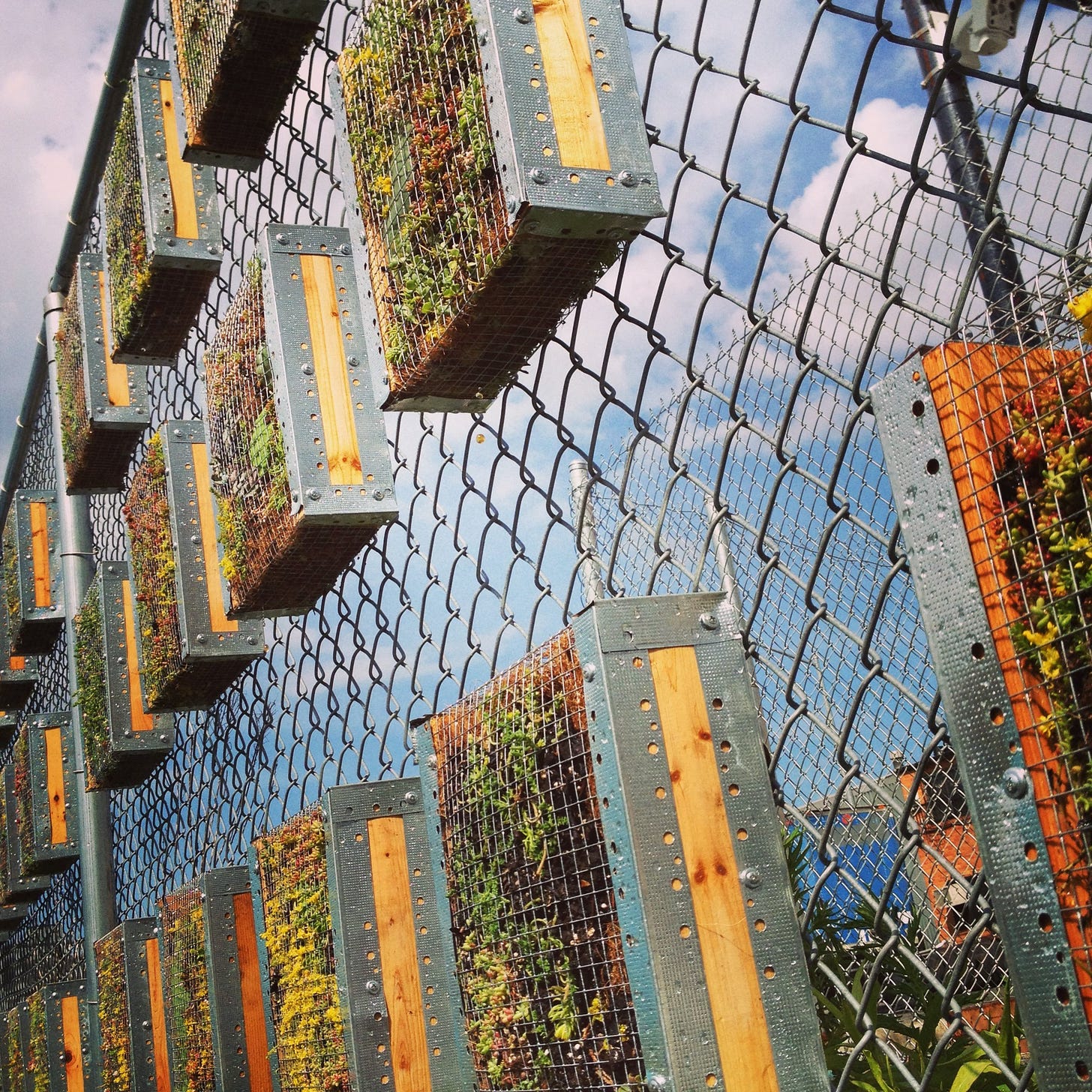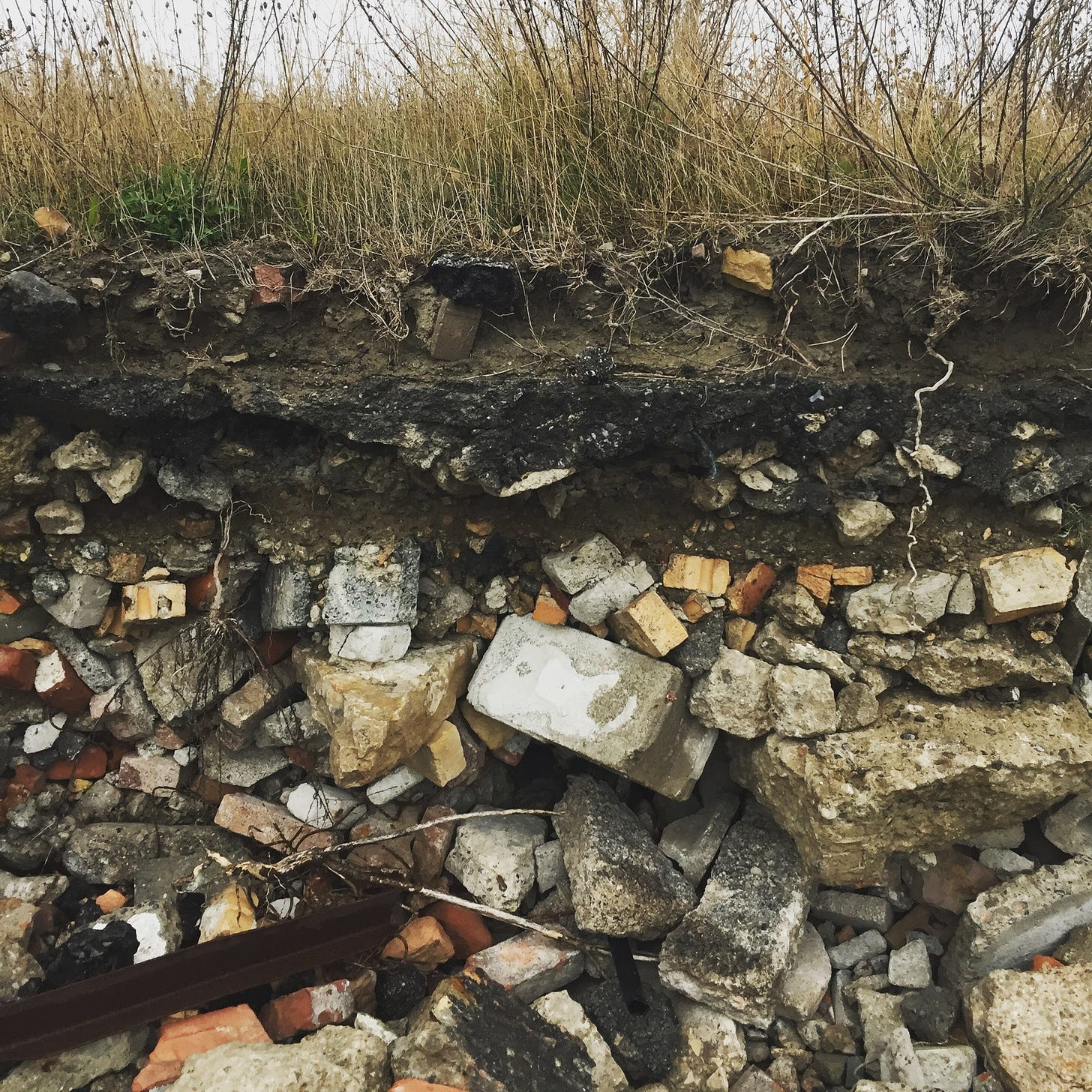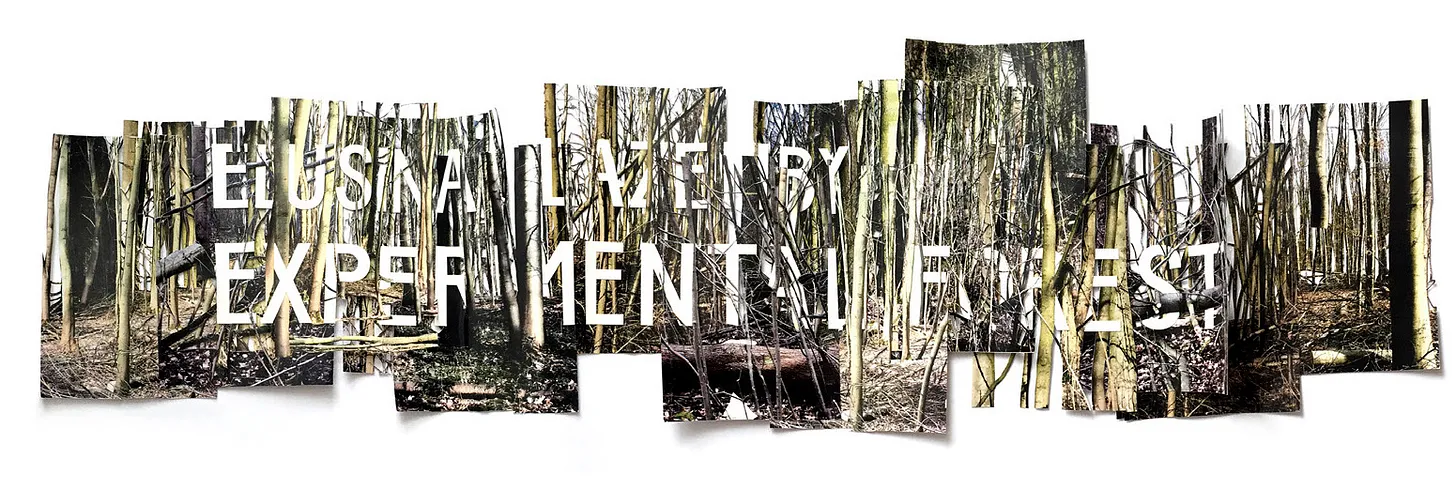Wendy Andringa, founder of Assemblage Landscape Architecture, digs into the complex layers of New York’s urban landscape with curiosity and technical know-how. A professional landscape architect with 20 years of experience at renowned New York firms like Scape and Starr Whitehouse and teaching appointments at Columbia and the Spitzer School of Architecture, Andringa is building a practice on her own terms, informed by a deep commitment to community and ecological invention.
We spoke about the power of “assemblage”, rooting into the community, her inventive urban soil research, and her new large-scale climate-adaptation projects.
How do the metaphoric and material interpretations of the word assemblage inform your practice? Are there links to your earlier photocollage work?
The name Assemblage has its roots in my montage photography. The material practice gives the photomontage approach a new dimensionality in materials and time. With montage, I used the camera to gather fragments of the world, which I would reorganize in the darkroom, with the assistance of the creative process and happy accidents. I intuitively combined diverse elements at multiple scales that play with perception and expectations. The results were often poetic, ironic…or just weird. When I discovered landscape architecture, I was drawn to these aspects with an ecological twist. Assemblage’s approach to landscape architecture is like photomontage but in real space with living things—a reorganizing of biodiverse elements to create landscapes that engender new possibilities.
Assemblage’s approach to landscape architecture is like photomontage but in real space with living things—a reorganizing of biodiverse elements to create landscapes that engender new possibilities.
We create new possibilities at Assemblage by approaching project challenges in innovative ways. This involves client education and trust building, like having the guts to propose something like managing waste onsite through salvage and reuse. It’s also fun to bring a child's-mind to every project, even when we are supposed to be the experts of tried and true methods. I like the energy that the next generation of designers bring to the drawing table - they ask good questions and push ideas forward because they haven't heard NO yet and aren't as concerned with appearing “expert.” The desire to be an expert often suppresses essential parts of the design process…that's when we turn into sheep.
Your background is in art and environmental activism in Brooklyn. There’s an expositional approach to your work as a practitioner: you’re digging into the stories to bring compassion and authenticity to projects that physically change the environment. How do these two roles—the activist and the builder-anchor one another?
I have volunteered with the Gowanus Canal Conservancy, a Brooklyn-based nonprofit, from its beginning to the industrious organization it is today. In the early 2000s, the Gowanus neighborhood was still an untamed place for experimentation; feral waterfront lots were everywhere. As emerging designers who wanted to make stuff and have fun, we invented projects that aimed for a more accessible and ecologically viable corridor. I enjoyed this collaborative environment, working with materials and seeing tangible results.
While developing my skills in various landscape architecture offices, I was always seeking this same type of creative atmosphere at work to balance the pragmatic aspects of the profession. Assemblage evolved from this ethos: I want my work to be my activism and bring my values to every project.
I want my work to be my activism and bring my values to every project.
Regarding exposition, we need to articulate our visions with graphic clarity and intelligence so clients and stakeholders understand our value to every project. Even today, the average person doesn't know what we do as landscape architects—the complexities of the natural world go unrecognized until a flood or weather-related disaster happens. We always strive to help clients and stakeholders see and understand the complexity and interdependence of systems.
You developed an environmental education workshop for middle school students where they build stormwater infiltration modules. What made you choose to teach students about urban stormwater (a “natural” process) through fabrication?
The stormwater modules were initially conceived as a design challenge to create a square-foot garden for an urban setting. We developed the industrial-looking design and held a few build-it-yourself workshops in partnership with the Gowanus Canal Conservancy (GCC). Through the workshops, we learned that the process was a great hands-on way to bring people together to make a small urban garden they could take home, and people loved the collaborative effort! We realized the design had great green infrastructure potential when placed horizontally on an impervious surface.
We applied for a neighborhood grant to use the “square foot stormwater module” as a teaching tool with the GCC. They have a fantastic education outreach program that pairs with local middle school STEM curricula to teach youth about urban stormwater infrastructure and issues in Gowanus. We distilled the modules into a pre-cut “kit of parts” that would be somewhat manageable for students to build in a couple of hours. With each workshop, we taught the students about local watershed issues, combined sewer overflows, and green infrastructure. It was a fun, interactive way to teach, and they responded well to working with all the materials. For most of them, it was their first time using power tools, so they also learned to build things.
There is ongoing learning through stewardship as well. They put the finished modules in their [asphalt] schoolyard. They can watch them in action when it rains and water them when it doesn’t. The interactive approach facilitates learning and leaves a more significant impression. If we gave a green infrastructure presentation, they would be bored out of their minds! By building their modules, they can see the cause and effect of natural processes and feel a sense of agency about their environment through their actions.
Like the stormwater module workshop, your practice includes significant community work and engagement, such as Dolly’s Park (pro bono), volunteering with NYC Trees (civic stewardship), and Assemblage’s visioning work in Hudson, NY, which is a grant-funded project with the NY State Dept of Env Conservation. We are working in similar ways at Ruderal. While rewarding and informative, connecting these efforts to revenue-generating work can be challenging. How have you been successful in linking the two?
We are a young studio in our third year. Most of our revenue-generating links so far have been indirect. The most vital link is to the studio knowledge base, which will help with revenue generation over time in future projects. Our community engagement work with the City of Hudson was a significant part of the project brief: to create a community-driven climate-adaptive design. Most municipal planning projects of this scale incorporate an engagement process of some kind, and we need to demonstrate the experience and capacity to conduct creative engagement for future projects.
Pro bono community projects like Dolly’s Park are great for relationship-building. The process is so rewarding, and there is more opportunity to explore novel ideas that can augment low budgets—also an excellent skill to demonstrate for future projects. After Dolly’s was built, it did generate interest and led to another project for our studio. Our summer intern came to us via Dolly’s Park. We do volunteer tree stewardship because I love and can’t resist doing it when I see street trees suffering in compacted soil. The hands-on education is excellent for us all and contributes to the knowledge base.
SC: Your works have a sectional intelligence, be it about rising water levels or in terms of the way you build fertility and permeability in urban contexts. These “assemblages” include anthropogenic materials, such as slag and waste substrates. Can you describe how communication with sections exemplifies the “assemblage” approach to landscape?
Sections are helpful as analytical and narrative tools. Some of my early montage photographs speak about anthropogenic narrative in section, and I have always been fascinated by the buildup of anthropogenic debris. One of my favorite anthropogenic buildup moments is at the feral Tommy Thompson Park in Toronto, where the lake’s waves have exposed decades of detritus dumped on the shoreline, with a layer of soil and grasses on top—a perfect layer cake of industrial residues covered and uncovered by natural process.
At Assemblage, we draw sections early and often and apply time to sections to communicate change. Landscape architect Julie Bargmann reminds us to think of landscapes as a continuum in deep timeframes. The changing climate is bringing all of this to the fore; our climate-adaptive design work with the city of Hudson asks the community to plan the waterfront for the next generations through 2100. We created the animated section through the shoreline to communicate the rising high tide and the adaptive response to expand the park to higher ground. Of course, there are many ways to depict advancing water, but a section offers a human-scale perspective.
The term “unearthing” comes up for me in looking at your work, as you are unearthing the potential of places, people, and places for water to move.
I like unearthing as a metaphor for guiding people and places toward ecologically beneficial resiliency. I wish we could do more deep unearthing with our work. It takes vision, trust, and time. We have a green infrastructure project in the Bronx that is a geological wonder. It has a steep outcrop of Fordham gneiss sloping down to the building with about a 20-foot grade difference. The sloped site had been taken over by decades of garbage, construction debris, mugwort, bittersweet vine, and many other aggressive plants. But there were signs of hope: emerging sassafras shoots at the top of the slope pushed their way through the weedy understory layer.
There was much to unearth to invite the ecological and reveal the site’s potential. We knew it would be hard to mine the aggressive species, but we had no idea how much patience and effort we’d need before installing the meadow. After installing the slope stabilization and green infrastructure, we saw we’d need to stay involved for another year to see the field to completion. The client already had a maintenance contract with the installer, so we initiated a separate agreement to guide the maintenance. Thank god the client is patient because our continued involvement has been the key to success, and the process has also been a deep unearthing of knowledge.
SC: You work with local materials, often remixing them to create new ecological materials. This novel approach moves beyond the symbolic or static uses of recycled materials.
We use salvage materials to help keep the site narrative intact and be resourceful with small budgets. At Dolly’s Community Park, we integrated salvaged bricks and timber beams from nearby demolition sites. We reutilize “waste” materials to make new landscape materials. We are experimenting with making soil media— I say “media” as it’s not yet soil and lacks minerals.
As an industry that designs urban environments, we’re at a point where we could redefine/rebrand the concept of “urban soil.”
As an industry that designs urban environments, we’re at a point where we could redefine/rebrand the concept of “urban soil.” Most soil components are imported to cities from the hinterlands, so why not explore all the waste materials we already have for soil-making? Cardboard is abundantly available everywhere, and when combined with vegetable scraps, it composts to attract all kinds of beneficial microbes. The microscope helps with proof of concept, and it is so fun to see all the creatures that move into the brown food web. Creating an environment for tiny organisms out of nothing but waste is incredible-you don’t need to go to Home Depot to buy compost for a small-scale garden!
You recently bought a microscope to experiment with building soils with recycled and surplus materials. What drives your interest in soils? Is this also related to “assemblage”?
WA: The soil-building project is an experiment in creating homemade growing media from waste materials for a rooftop pollinator garden. My interest in soil has evolved from years of observing plant establishment and learning from consultants like Eric T. Fleischer (F2 Environmental), who designs soil biology. Good soil is living matter, and plants depend on good soil for nutrient exchange. Construction takes a significant toll on soils due to the stripping and excavation by heavy equipment.
Soil is an unexplored vein of conceiving site construction. The ideal soil assemblage encourages soil biodiversity. For that, you need a proper mineral matrix with air space and the right amount of organics to support insects and microorganisms in the soil. Until plants are established, compost is necessary. I read about the regenerative farmer who converted brushland to farmland by scattering corn feed into the brush and letting the pigs go to town, rooting through the area. This made so much sense—why should she need heavy equipment compacting the soil before farming it? The pigs help clear the brush with a light touch and leave behind organics that add to the soil biology. If you think about soil at a micro-scale, adding compost is the same type of invitation to bugs and microbes: come hither and find your food here! The insects will do the mining work, so we need to create the right environment for the “brown food web” to occur.
At Assemblage, we want soils to be considered in all types of projects and see thoughtful soil restoration plans included in small-budget public projects, with soils being remediated and restored in place whenever possible. This is especially important in brownfield redevelopment projects if hauling away contaminated soils is cost-prohibitive. We would love to hear about other’s experiences with this!
Tell us about your Hudson, New York project, which began with community engagement events and is now gaining its “assemblage” of sectional ideas.
We did a year-long community-driven climate-adaptive design project with the city of Hudson. Our team included urban planner Kaja Kühl of youarethecity, who choreographed the community engagement, and eDesign Dynamics, ecological engineers who advised on the biodiverse living edge and intertidal green infrastructure design. It was a grant-funded project awarded by the NY Department of Environmental Conservation and Hudson River Estuary Program, and the charge was to partner with a Hudson River-based municipality to address climate-related issues of flooding and sea level rise on a city-owned waterfront parcel.
We partnered with the city of Hudson to propose climate-adaptive design and planning improvements to their waterfront park. The park is built on industrial fill, subject to sea level rise, and is now the heart of the city’s waterfront recreational life. We planned a participatory and interactive engagement strategy to gather community input from the broadest cross-section possible. In addition to establishing a project Advisory Group that met publically every two months, we held focus group workshops and interactive public meetings. Local nonprofit groups helped us create an inclusive youth and environmental education engagement component. We had meetings in the park with printed/ laminated boards and led tours so we could explain the design proposals in situ.
This park floods during big storms, so we reinforced the urgent need for change with site-based methods. Before each site meeting, we installed our pink “high tide tape” and flags to illustrate the future shoreline at mean high tide in 2100. People walk this line and see the impacts of climate change in situ. These tools galvanized support for our proposed park design, which was adopted into the city’s strategic plan. As we await funding for the next phase, we seek grants in environmental education and water quality testing. We’re planning a remediation demonstration project for new green spaces in the upland areas. We love to connect with other people researching remediation.
Thank you, Wendy, for sharing your work and ideas with us, and we look forward to watching your practice and projects evolve!
This interview has been edited for length and clarity. Photos by Wendy Andringa.
Follow Wendy and Assemblage Landscape at https://assemblagelandscape.com/ and on Instagram at @assemblagelandsacpe.
Read on Substack




